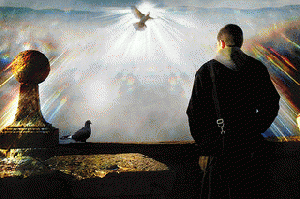World war and violence is a reflection of inner war and violence. What causes inner war and violence and is it really possible to achieve inner and outer peace?
All sorts of big and small things disrupt our sense of peace in life. Failed relationships, mounting bills, health concerns, parental stresses, work overwhelm, loss, poor sleep, traffic irritations, losing your keys, the cat breaking a vase; the list goes on and on.
Buddhism attempts to create peace by teaching people to be unattached to worldly happenings. But is this philosophy realistic? Can someone who is deeply attuned to themselves and the world around them be unaffected physically, emotionally, and spiritually by the events and changes that take place each and every day? Would we even want to be? It would be nice to numb the bad feelings, but what about the good ones? Many people would not want to forego deep joy and pleasure in order to be in a constant state of tranquility. Furthermore, are the bad feelings part of growth and transformation, akin to labor pains, to be welcomed as part of the whole of life?
The physical world is driven by balance. When the human body is out of balance, a lack of peace occurs a breeding ground is created for illness and dis-ease. When people feel hopeless emotionally, they seek to come back into balance. People become addicted to food and substances not because they are dysfunctional, but because they are naturally seeking harmony and balance in their lives when it's out of whack.
Even feelings of elation can be overwhelming and disrupt balance. Have you ever noticed that when you feel full of excitement and passion, you almost need some relief? It's because the scales are tipped and even though the feelings are "good," there's not a sense of inner peace. It's one sided and, therefore, unstable.
People often have their own unique issues that grip them and disrupt their inner peace in a deeply grooved pattern over a number of years or even a lifetime, such as addiction, relationship troubles, and chronic health conditions. In these cases, their equilibrium has adapted to getting balance by going through extremes, and tolerance is built. In order to break the pattern, they would have to change other parts of their lives, as well. It would likely feel extremely scary and lonely (despite it being for a positive purpose), which causes anxiety and puts the body back OUT of equilibrium. Continued fight-or-flight freezes our nervous system and can cause organs to shut down. Hence, people stay in cycles that ultimately hurt them.
The key is to recognize reflex, automatic memories, expectations, attitudes, behaviors, and assumptions that lead us to the repetitive painful cycle. For example, someone who has struggled with romantic relationship issues throughout their lives might have attachment issues that cause them to feel like they have to hang on to relationships that don't serve them. If they attune to their own needs, they would know when to let go.
The research of Dr. John Bolwby in psychiatry and Dr. Mary Ainsworth in psychology indicates that our relationship patterns are formed during our earliest years, based upon the level of attunement our caregivers demonstrated with us. Those whose caregivers were not well-attuned to the child's non-verbal cues form relationship patterns that can lead to great distress and relationship problems in adult life.
At the end of the day, humanity has a universal need to feel bonded & attached to loved ones. When we do not feel securely attached and able to love and be loved, we do not feel well and at peace. While we can't go back in time and change our formative years, we can do the most tender and important work that can ever be done, which is to heal our relationship wounds and commit ourselves to love, no matter how painful, frightening, or difficult. Once we feel love and secure attachment, peace can be had.





